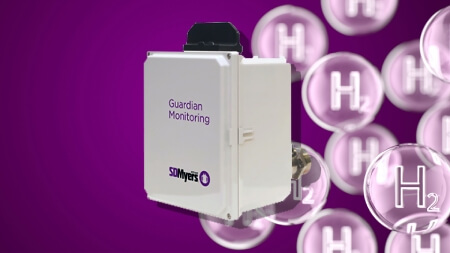News & Events

Where Does Single Gas Online Monitoring Fit In Your Fleet?
As online condition monitoring equipment for oil filled transformers becomes more and more prevalent, the available hardware options become more sophisticated and complex. One piece of technology, however, remains an essential piece of equipment for transformer monitoring. Its strengths are its simplicity and its reliability. For now, even among cutting edge multi-gas monitoring systems with built-in capabilities that reach far beyond what was thought possible only a few years ago, the single-gas monitor still has a place on many transformers in commercial and industrial America.
“The single-gas monitor allows transformer owners to have instant understanding of one key data point on a transformer's health,” said Wesley Suplit, product manager at SDMyers. “That data point is the presence of the dissolved gas called hydrogen.”
Dissolved hydrogen is generated by many common transformer faults. One of the key indicators of a breakdown of transformer oil is the presence of hydrogen. This provides an early warning of insipient faults, Suplit said, and helps transformer owners know when it’s time to act and perform more thorough diagnostic tests. It provides the asset owner with an early indication of a potential bigger problem where they can act and respond in a timely manner before further damage is caused.
“When faults happen in a transformer—whether they're from electrical problems or thermal problems or external problems—they cause the oil in a transformer to break down in certain ways,” Suplit said. “So, it's this very interesting chemical and electrical reaction that occurs that gives us a symptom, gives us a sign that there could be a problem that's occurring within that transformer.”
As hydrogen is present in most faults, a rise in the parts per million (PPM) is no more than a binary early warning sign. Because the nature of the fault is not detected, further testing has to take place to make a diagnosis.
Single-gas monitors are best utilized in electrical distribution, industrial and commercial applications, Suplit said, rather than earlier in the electrical grid or on highly critical equipment.
“The power system has transformers all along the electrical grid and those transformers are placed at the point of power generation, at the place of power transmission, and then—more familiarly to people who live in neighborhoods, communities and towns—they're placed where electricity needs to be distributed,” Suplit said. “Single-gas monitors work at a place where transformers don't have as large of a protection system, or they don't have as robust of a maintenance and monitoring program because they serve those distribution type transformers, transformers that might commonly be overlooked as something that should be maintained.” An advantage of single-gas monitors is that a potential problem can be flagged and addressed early rather than waiting for the next annual oil sample report.
There are, of course, inherent limitations to single-gas monitoring systems—slightly less accuracy than laboratory or multi-gas systems and much fewer diagnostic capabilities. Nothing beyond the early warning afforded by hydrogen. But Suplit says that the simplicity of the device is the best fit for many transformer owners.
“We have specifically designed [the G1 monitor, SDMyers single-gas offering] to not be oversized for its intended fit,” Suplit said. “It is not intended for the highest voltage transmission transformers that may be more appropriate to use multiple monitoring technologies and multiple physical monitoring capabilities, like thermography and partial discharge inspections.”
Single-gas monitors tend to be robust and reliable. SDMyers’ G1, Suplit says, is no different, and the “set-and-forget” aspect of the equipment is popular with customers.
“It doesn't require any maintenance. It doesn't require any calibration. It's stable over a long period of time. Many customers want something they can set and forget, but they want that in the context of moving into a more digitally fluent way of understanding the health of their equipment,” Suplit said.
As with all remote monitoring options, security is an important consideration. The G1, Suplit says, provides data via a secure network.
“We have, for a long time, offered a service that collects that data through a VPN over a cellular system to collect that data into SDMyers database, post it on the Transformer Dashboard, and allow that data to be used by SDMyers diagnostic staff to make decisions and then communicate and collaborate with our customers.”
SDMyers is working on providing alternatives to the connected diagnostic service to make the equipment data accessible a variety of different, secure ways.
“That might mean getting the data through a hardwired connection to a system that is internal to an organization, whether it's to a SCADA system or a data historian or another interface to allow that data to be useful, to make decisions.” Suplit said.
The G1, Suplit said, remains so popular because of its longevity and dependability.
“It just works. Technology is always changing and always evolving to get better. We don't think we've met the limit of that, but this is a piece of technology that can stand the test of time,” Suplit said.
“It is fantastic to meet the needs of customers who have critical distribution transformers, customers who want to move their monitoring and maintenance philosophy in a way that embraces digital technology for better decision making.”
April 05, 2022
 Please wait while logging in.
Please wait while logging in.